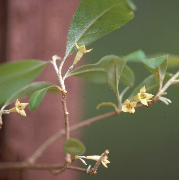Autumn Olive
Elaeagnus umbellata Autumn Olive
Common Names: autumn olive, oleaster, Japanese or Asiatic Silverberry
Native Origin: This East Asian native was introduced to the U.S. in the 1830s as an ornamental plant and for erosion control. It now occurs throughout the Eastern and Midwestern U.S. and is moving into the Central Plains and West.
Description: A deciduous shrub or small tree that grows to about 20 feet tall. Leaves are dark green with silver-white scales on the underside. The alternate, oval to lance-shaped leaves are untoothed. Small light yellow flowers appear along the twigs early in spring and are followed by great quantities of small, red, juicy fruits. Birds forage on the berry-like fruits, contributing to the spread of this plant.
Habitat: Autumn olive grows well in a variety of soil types, including sandy, loamy and even clay textured soils. Its roots fix nitrogen, which allows it to flourish even in poor soils. Mature trees tolerate some shade, but produce more fruit in full sun. It is drought tolerate and invades grasslands, glades, sparse woodlands, pastures, fields and roadsides.
Ecological Impacts: Rapid growth and prolific seeding makes Autumn olive a serious invasive plant pest. Plants rapidly establish large and growing colonies. The nitrogen fixing ability can adversely impact native plants that depend on infertile soils.
Similar species: Autumn olive may be confused with Russian olive, a closely related species, which also is a nonnative invasive. Russian olive is usually very thorny (Autumn olive is sparsely thorned), and has larger, olive-shaped, mealy fruits.
Control and Management: Because the stumps sprout readily and seeds are so abundant, resprouts and new seedlings are common. Autumn olive may require repeat treatment for full control.
Manual: Seedlings and sprouts can be hand-pulled from moist soil to ensure removal of the entire plant and roots. Please note: on larger plants, cutting alone results in thicker, denser growth, as does burning during the dormant season.
Chemical: Foliar spraying with systemic herbicide is effective. Since spraying must be done when plants are actively growing, care should be taken to avoid non-target species as much as possible.
Combination: On sites, such as near wetlands or streams, where largescale spraying is not desirable or when impact to non-target species is to be minimized, a combination of manual and chemical means may be best. In these circumstances, cut the shrubs to the lowest possible common stem(s) and then carefully paint, daub or squirt systemic herbicide on the remaining cut surface. This is most effective when fruits have not formed or are not ripe; otherwise, care must be taken to remove the plant(s) from the area to avoid scattering seed.
Comments are currently closed.




